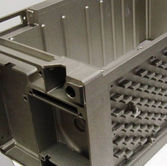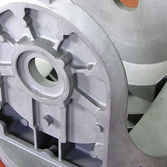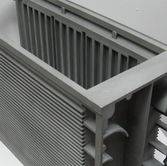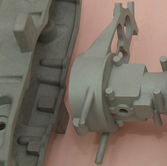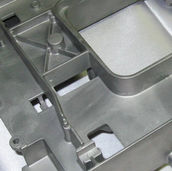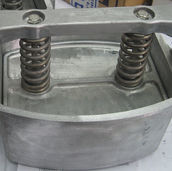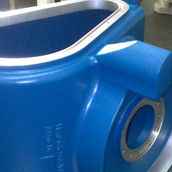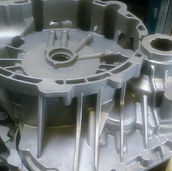Precision Casting
LOST WAX (INVESTMENT) CASTINGS
The precision investment casting process involves making of a disposable wax pattern by injecting specially prepared wax into metal die. The resulting wax patterns are then assembled on to a runner system to form a cluster.
A ceramic shell build to the assembly by application of a series of ceramic slurry (investing) and coatings. Then the ceramic shell mold is de-waxed and fired at a high temperature to sinter. The ceramic mold is then filled with molten metal, which solidifies in the shape of the original wax pattern.
After the casting has frozen, the ceramic mold is broken away from the casted parts. Finally casting parties processed at finishing area to the requirements of the customer.
It is possible to use 3D printed parts as replacement for wax that comes from mold. This process is reffered to as 'Fast Casting' or 'RP Casting' and can significantly shorten manufacuring time and reduce up-front costs for mold.
DIE CASTINGS
The metal is injected into the mold under high pressure of 10-210 Mpa (1,450- 30,500) psi.
This results in a more uniform part, generally good surface finish and good dimensional accuracy, as well as 0.2% of casting dimension. For many parts, post-machining can be totally eliminated, or very light machining may be required to bring dimensions to size.
Die Casting can be done using a cold chamber or hot chamber process.
In cold chamber process, the molten metal is ladled into the cold chamber for each shot. There is less time exposure of the melt to the plunger or the plunger walls
This is particularly useful for metals such as Aluminum and Copper (and its allows), which alloy easily with iron at the higher temperatures.
In a hot chamber process the pressure chamber is connected to the die cavity is immersed permanently in the molten metal. The inlet port of the pressurizing cylinder is uncovered as the plunger moves to the open (unpressurized) position. This allows a new charge of molten metal to fill the cavity and thus can fill the cavity faster than the cold chamber process
The hot chamber process is used for metals of low melting point and high fluidity such as tin, zinc, and lead that tend not to alloy easily with steel at their melting temperatures.
Die casting molds tend to be expensive as they are made from hardened steel. Also the cycle time for building these tend to be long. Furthermore the stronger and harder metals such as iron and steel cannot be die-cast.
SAND CASTINGS
In the sand casting process, a pattern is made in the shape of the desired part. The patterns are typically made of wood, plastic, or metal. A single piece or solid pattern is used for simple designs. Patterns that are more complex are made in two parts, called split patterns.
The upper part of a split pattern is called a cope, while the bottom section is called a drag.
Where the cope and drag separate is known as the parting line. Both solid and split patterns can have cores inserted for completing the final part shape. When making a pattern it is necessary to taper the edges so the pattern can be removed without breaking the mold.
The pattern is housed in a box called the flask, and then packed with sand.
A binder helps harden the sand into a semi-permanent shape. Once the sand mold is cured, the pattern is removed. This leaves a hollow space in the sand in the shape of the desired part. The pattern is made larger than the cast to allow for shrinkage during cooling. Sand cores can then be inserted in the mold to create holes and improve the casting's overall shape. Simple patterns are usually open on top, allowing molten metal to be poured into them. Two-piece molds are clamped together. Molten metal is poured into a pouring cup where it will then travel down a sprue and into the gating system. Vent holes are created to allow hot gases to escape during the pour. Ideally, the pouring temperature of the molten metal is a few hundred degrees higher than the melting point, assuring good fluidity.
The temperature difference also prevents premature cooling and resulting voids and porosity. After the metal cools, the sand mold is removed and the metal part is ready for additional operations, such as cutoff and grinding.
PLASTER MOLD CASTINGS
The plaster mold casting process is perfect for making die casting similar prototypes in aluminum, magnesium or zinc. Furthermore low volume series - or pilot productions of typical 1-50 to 500 pieces are ideal for this technology.
Using high precision CNC machining or by Rapid Prototyping methods a set of plastic mold halves are produced. These mold halves are then converted into a set of positive rubber molds which serve as production tool. Based in this sift rubber tool an unlimited number of plaster molds can be made. The plaster molds are then assembled and fluid metal is poured into the cavity. After the casting stage, the parts are cleaned and a number of post treatments can be offered.


